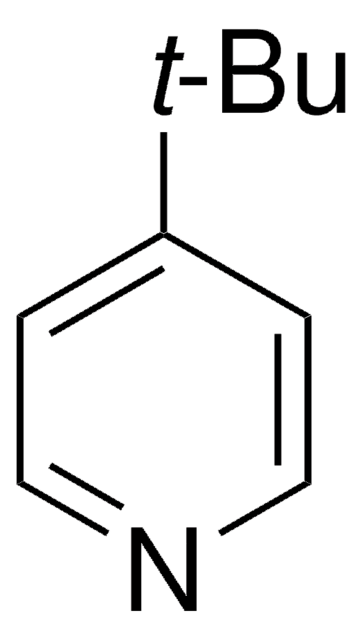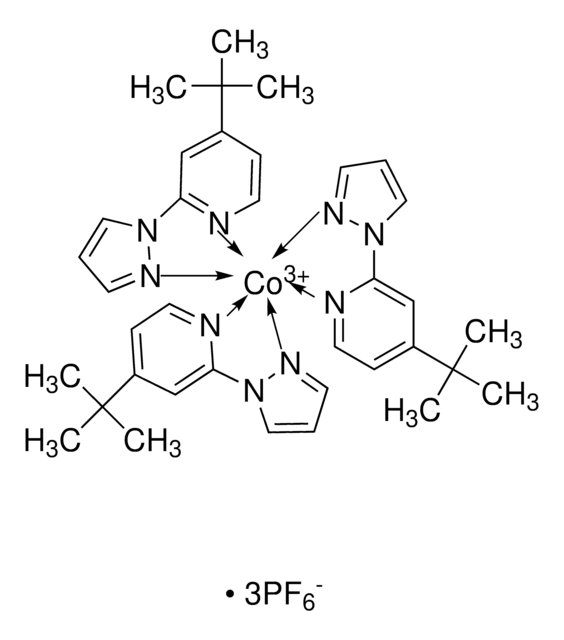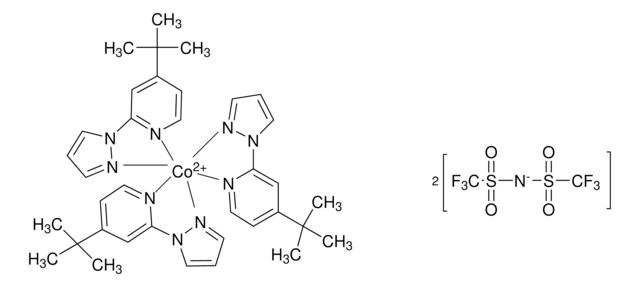Wichtige Dokumente
805394
FK 209 Co(III) TFSI salt
Synonym(e):
tris(2-(1H-pyrazol-1-yl)-4-tert-butylpyridine)cobalt(III) tri[bis(trifluoromethane)sulfonimide]
About This Item
Empfohlene Produkte
Assay
98%
Qualitätsniveau
Form
powder
mp (Schmelzpunkt)
281.5 °C (exp.)
SMILES String
O=S([N-]S(=O)(C(F)(F)F)=O)(C(F)(F)F)=O.O=S([N-]S(=O)(C(F)(F)F)=O)(C(F)(F)F)=O.O=S([N-]S(=O)(C(F)(F)F)=O)(C(F)(F)F)=O.CC(C)(C)C1=CC(N2N=CC=C2)=NC=C1.CC(C)(C)C3=CC=NC(N4C=CC=N4)=C3.CC(C)(C)C5=CC=NC(N6C=CC=N6)=C5.C
Verwandte Kategorien
Allgemeine Beschreibung
Anwendung
Signalwort
Warning
H-Sätze
Gefahreneinstufungen
Eye Irrit. 2 - Skin Irrit. 2 - Skin Sens. 1 - STOT SE 3
Zielorgane
Respiratory system
Lagerklassenschlüssel
11 - Combustible Solids
WGK
WGK 3
Flammpunkt (°F)
Not applicable
Flammpunkt (°C)
Not applicable
Hier finden Sie alle aktuellen Versionen:
Besitzen Sie dieses Produkt bereits?
In der Dokumentenbibliothek finden Sie die Dokumentation zu den Produkten, die Sie kürzlich erworben haben.
Kunden haben sich ebenfalls angesehen
Artikel
Dye-sensitized solar cells (DSCs) are 3rd generation solar cells combining the promise of high efficiency with low production costs.
Dr. Perini and Professor Correa-Baena discuss the latest research and effort to obtain higher performance and stability of perovskite materials.
Next generation solar cells have the potential to achieve conversion efficiencies beyond the Shockley-Queisser (S-Q) limit while also significantly lowering production costs.
For several decades, the need for an environmentally sustainable and commercially viable source of energy has driven extensive research aimed at achieving high efficiency power generation systems that can be manufactured at low cost.
Unser Team von Wissenschaftlern verfügt über Erfahrung in allen Forschungsbereichen einschließlich Life Science, Materialwissenschaften, chemischer Synthese, Chromatographie, Analytik und vielen mehr..
Setzen Sie sich mit dem technischen Dienst in Verbindung.







![Poly-[bis-(4-phenyl)-(2,4,6-trimethylphenyl)-amin] a poly(triaryl amine) semiconductor](/deepweb/assets/sigmaaldrich/product/structures/122/933/c34a34ab-284f-4890-adb8-126247a91d9b/640/c34a34ab-284f-4890-adb8-126247a91d9b.png)
![[6,6]-Phenyl C61 Buttersäuremethylester >99%](/deepweb/assets/sigmaaldrich/product/structures/359/221/d990c746-0960-4c69-bf76-fe09b193824d/640/d990c746-0960-4c69-bf76-fe09b193824d.png)
